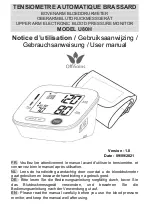
Page 30
WELD SENTRY 2
R (RANGE) CONTROL CHART - The range, R, of each sub group is calculated and represented by a data
point on the R control chart. The range is the difference between the highest and the lowest value in a sub
group. For example, if the values in a sub group of 3 are 20, 10, 20 and 40, the range is 40 - 10 = 30. A
single point representing 30 is shown on the R control chart for that sub group. The line in the center of the
chart is the average value of all the data points, and is called R bar.
X BAR (AVERAGE) CONTROL CHART - The average, X bar, of each sub group is calculated and
represented by a data point on the X bar control chart. The average is calculated by adding all of the values
in the sub group and dividing by the sub group size. For example, if the values in a sub group of 3 are 20,
10, 20 and 40, the X bar, is (20+ 10+ +20+40)/3=30. A single point representing 30 is shown on the X bar
control chart for that sub group: The line in the center of the chart is the average value of all the data points,
and is called X bar bar.
CONTROL LIMITS - Upper and Lower Control Limits should not be confused with the programmable
Upper and Lower Limits on the Run screen of the Weld Sentry. Control Limits refer to SPC theory and are
not applicable unless statistical process control is being implemented. This requires some previous
knowledge of SPC. Those users may wish to enter Control Limits to cause alarms for “out of control”
conditions as opposed to using Reject Limits to cause alarms for “bad” welds. Refer to Appendix A for
formulas used by the Weld Sentry for SPC calculations.
SAMPLING MODE -
Select this feature from the
SPC
Menu to change the method in which the Weld
Sentry saves measurement results in SPC History. This is a system parameter and affects all Sentry
schedules and changes the Sampling Period on all X & R Control Chart screens. If the Sampling Mode is
changed all prior SPC History is erased.
Содержание 3-131-XX
Страница 5: ......















































